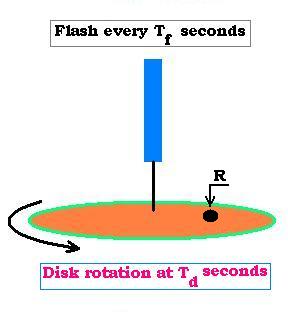Contents
© The scientific sentence. 2010
|
Stroboscope
1. The stroboscope:
The stroboscope is used to measure speed; or example, to measure the period Td of a rotation of
a disk. To study the phenomenun, we should set some unique part on the rotating object as an index or
reference ; like the point R in the figure.
Here is the principle:
Every Td secondes, we have a flash that illuminates a disck rotating at Tr
secondes. If k is an integer, and we assume that the disk rotates clockwise, we have the following
cases:
1)- Tf = k x Td: That is between two flashes, the disk has made
exactly k revolutions. The disk seems stationary.
2)- Tf = Td/ k: That is during the unique revolution
of the disk ( between two flashes), the reference index is illuminated k times. We
will see the hole k times. The point reference is illuminated at every
2π x r /k ( r is the radius of the disk).
3)- Td = Tf + gap: Between two illuminations, the reference point is
late of gap seconds. Between every two following flshes, the reference point becomes late of gap
seconds. Forethermore, It seems then the disk rotates in the reverse direction (counterclockwise).
4)- Tf = Td + gap: Between two illuminations, the reference point is
ahead of gap secondes. Between every following flsh, the reference point becomes ahead of gap
secones. Forethermore, It seems then the disk rotates in the real direction (clockwise).
In practice, the spectroscope is used to mesure frequencies of phenomena. in the device, we set, at first,
the revolution Td of the object greater the of the flash Tf; that is we
start at the highest flash rate and adjust the flash rate down. Once the refrence point seems
stationary, the two frequencies are equal.

2. Example:
If the object rotates at x RPM (Rotations Per Minutes), we start to set the flash rate;
let's say at 2000 FPM (Flashes Per Minutes). If we see the reference point four times during
a revolution, then x = Td = 2000 / 4 = 500 RPM.
If we slow the flash rate at 1000 FPM, we will see the point reference 2 times, foretheremore
x = 1000 / 2 = 500 RPM ... till 500 FPM to see the reference point stationary.
We still continue to see the reference point stationary at the lower flash rates at
Tf = Td/k; with k = 5, 4, 3, 2, or 1.
Remark that at the very high flash rate (until the speed of light) we will see the reference
point evrywhere in the disk.
|
|